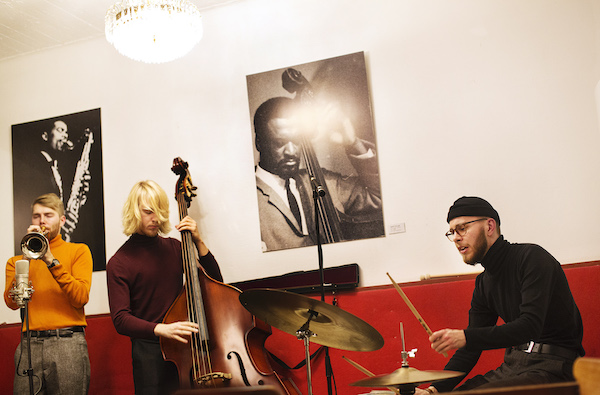Apr 2, 2024 12:59 PM
Saxophonist, Sonic Explorer Casey Benjamin Dies at 45
Casey Benjamin, the alto saxophonist, vocalist, keyboardist and producer who stamped his distinctive sounds on the…

The Bowman Trio
(Photo: Maarit Kytoharju)Scandinavian jazz is its own thing. Affective, free-spirited and daringly improvisational. Finnish jazz, a vibrant constituent of the Nordic scene, pushes this individualism to an uncommon degree. Producer Matti Nives champions the effort through We Jazz, a music collective whose wingspan covers a magazine, an annual jazz festival and a record label. This fall, three new releases on the Helsinki-based We Jazz Records affirm the ascendancy of the Finnish small group approach to the music.
Helsinki-based drummer Joonas Leppänen leads the quartet Alder Ego on II (WJ10; 38:07 ★★★1/2), the second recording for this ensemble of prominent Finnish players. The group aesthetic accentuates synchronized horns on disjointed melodies against cool, conversational percussive lines—the band is ever in motion, always presaging the next thing. With this in mind, the seven originals here proceed almost like chapters in a book: On “Leviathan,” the opening track, listeners first hear the discord between Tomi Nikku’s trumpet and Jarno Tikka’s sax. Later, on the angular “Cubism,” each player takes a turn in asserting his singular voice through masterly solos, and later still, on “Flight,” these individual statements begin to coalesce into a soaring narrative. By the final cut, “Solitude,” the soloists have settled into a unison voice held in place by bassist Teemu Åkerblom’s determined punch on the quarter note. To absorb the relatedness in these tracks, though, it’s best to listen to the entire album in one sitting. Leppänen, who spent some time developing his craft in Sweden, Germany and the U.S., raises the bar with these absorbing, expressionistic compositions.
We Jazz Live Plates, Vol. 1, Berlin 27.10.17 (WJ09; 46:27 ★★★★) is the first of We Jazz’s live albums, recorded, as the title suggests, in Berlin during autumn 2017. The album captures two tunes each from the three Finnish trios that headlined at the Scope Festival, a German-Finnish event held in the heart of Berlin’s counterculture club district. Despite the hipster locale and the raw vibe of the live recording—at times on different tracks a siren wails in the background—most of album features unadulterated swing, albeit of the contemporary Sámi variety. Don’t underestimate the excitement here—these aren’t your standard swing tunes. The Bowman Trio sets into an infectious bounce on “The Hillary Step” and offers up plenty of ardent, straightahead soloing all around, but the melody is strictly modern. Then the more lyric Jaska Lukkarinen Trio interjects smart, upbeat references to Charlie Parker’s burner “Donna Lee” on “Pengerkadulla 2017,” but the mood is otherwise decidedly relaxed. Finally, Black Motor, the third trio—which enhances its free composition with borrowings from world music (no swing here)—reprises the title cut from their 2017 We Jazz release Branches. The tune opens with a plaintive call on the South Indian nagaswaram—a signal that what follows will reach beyond the band’s Nordic horizons.
Swedish-born, Berlin-based saxophonist Otis Sandsjö makes his recording debut on We Jazz with the ambitious Y-OTIS (WJ08; 36:42 ★★★). Of all the new We Jazz releases noted here, Sandsjö’s is the only one to use chordal instruments—in this case, a keyboard and three synthesizers. The use of keys has less to do with harmonic expression than with his exploration of jazz as a flexible (and accommodating) art form, though. On these compositions, Sandsjö pairs electronica with free improvisation to create what he dubs “liquid jazz,” a boundary-less genre that lies somewhere between post-bop and the avant-garde. Shifts between the two can seem impetuous: His tune “pata pata” starts with a sax riff in easily understood jazz-speak that morphs into an otherworldly techno section—a surprise, but not an unpleasant one. On tunes like “BOO!,” with its repeated folk licks and growling bass, and “ACINOR,” with its fast, fluttering cooperation between sax and synth, Sandsjö integrates the electronic bits more neatly. DB

Benjamin possessed a fluid, round sound on the alto saxophone, and he was often most recognizable by the layers of electronic effects that he put onto the instrument.
Apr 2, 2024 12:59 PM
Casey Benjamin, the alto saxophonist, vocalist, keyboardist and producer who stamped his distinctive sounds on the…

“He’s constructing intelligent musical sentences that connect seamlessly, which is the most important part of linear playing,” Charles McPherson said of alto saxophonist Sonny Red.
Feb 27, 2024 1:40 PM
“I might not have felt this way 30 to 40 years ago, but I’ve reached a point where I can hear value in what people…

Albert “Tootie” Heath (1935–2024) followed in the tradition of drummer Kenny Clarke, his idol.
Apr 5, 2024 10:28 AM
Albert “Tootie” Heath, a drummer of impeccable taste and time who was the youngest of three jazz-legend brothers…

“Both of us are quite grounded in the craft, the tradition and the harmonic sense,” Rosenwinkel said of his experience playing with Allen. “Yet I felt we shared something mystical as well.”
Mar 12, 2024 11:42 AM
“There are a few musicians you hear where, as somebody once said, the molecules in the room change. Geri was one of…

Henry Threadgill performs with Zooid at Big Ears in Knoxville, Tennessee.
Apr 9, 2024 11:30 AM
Big Ears, the annual four-day music celebration that first took place in 2009 in Knoxville, Tennessee, could well be…